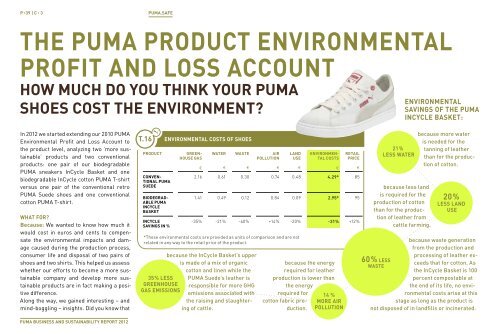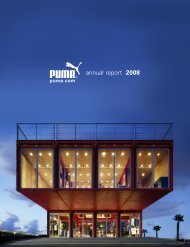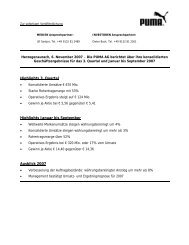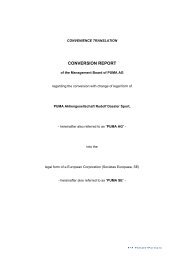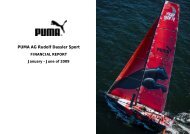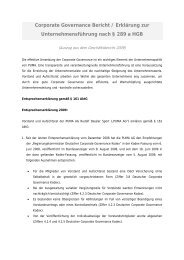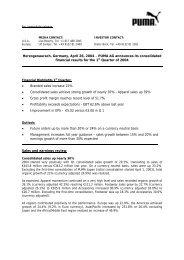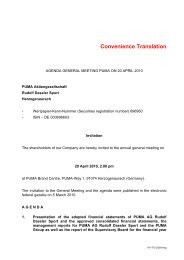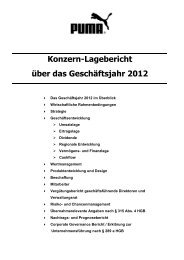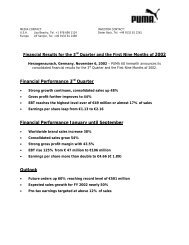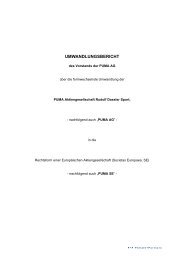Html - PUMA CATch up
Html - PUMA CATch up
Html - PUMA CATch up
You also want an ePaper? Increase the reach of your titles
YUMPU automatically turns print PDFs into web optimized ePapers that Google loves.
p : 39 | c : 3 <strong>PUMA</strong>.SAfe<br />
The puma producT environmenTal<br />
profiT and loss accounT<br />
how much do you Think your puma<br />
shoes cosT The environmenT?<br />
In 2012 we started extending our 2010 <strong>PUMA</strong><br />
Environmental Profit and Loss Account to<br />
the product level, analyzing two ‘more sustainable’<br />
products and two conventional<br />
products: one pair of our biodegradable<br />
<strong>PUMA</strong> sneakers InCycle Basket and one<br />
biodegradable InCycle cotton <strong>PUMA</strong> T-shirt<br />
versus one pair of the conventional retro<br />
<strong>PUMA</strong> Suede shoes and one conventional<br />
cotton <strong>PUMA</strong> T-shirt.<br />
whaT for?<br />
Because: We wanted to know how much it<br />
would cost in euros and cents to compensate<br />
the environmental impacts and damage<br />
caused during the production process,<br />
consumer life and disposal of two pairs of<br />
shoes and two shirts. This helped us assess<br />
whether our efforts to become a more sustainable<br />
company and develop more sustainable<br />
products are in fact making a positive<br />
difference.<br />
Along the way, we gained interesting – and<br />
mind-boggling – insights. Did you know that<br />
<strong>PUMA</strong> BUSineSS And SUStAinABility RePoRt 2012<br />
T.16 t.1<br />
producT greenhouse<br />
gas<br />
conven-<br />
Tional puma<br />
suede<br />
BiodegradaBle<br />
puma<br />
incycle<br />
BaskeT<br />
incycle<br />
savings in %<br />
environmenTal cosTs of shoes<br />
€<br />
waTer<br />
€<br />
wasTe<br />
€<br />
air<br />
polluTion<br />
€<br />
land<br />
use<br />
€<br />
because the energy<br />
required for leather<br />
production is lower than<br />
the energy<br />
required for<br />
cotton fabric production.<br />
environmen-<br />
Tal cosTs<br />
€<br />
reTail<br />
price<br />
2.16 0.61 0.30 0.74 0.48 4.29* 85<br />
1.41 0.49 0.12 0.84 0.09 2.95* 95<br />
- 3 5 % -21 % - 6 0 % +14 % -2 0 % -31 % +12 %<br />
*These environmental costs are provided as units of comparison and are not<br />
related in any way to the retail price of the product.<br />
because the InCycle Basket’s <strong>up</strong>per<br />
is made of a mix of organic<br />
cotton and linen while the<br />
35 % less <strong>PUMA</strong> Suede’s leather is<br />
greenhouse responsible for more GHG<br />
gas emissions<br />
emissions associated with<br />
the raising and slaughtering<br />
of cattle.<br />
14 %<br />
more air<br />
polluTion<br />
€<br />
60 % less<br />
wasTe<br />
21 %<br />
less waTer<br />
because less land<br />
is required for the<br />
production of cotton<br />
than for the production<br />
of leather from<br />
cattle farming.<br />
environmenTal<br />
savings of The puma<br />
incycle BaskeT:<br />
because more water<br />
is needed for the<br />
tanning of leather<br />
than for the production<br />
of cotton.<br />
20 %<br />
less land<br />
use<br />
because waste generation<br />
from the production and<br />
processing of leather exceeds<br />
that for cotton. As<br />
the InCycle Basket is 100<br />
percent compostable at<br />
the end of its life, no environmental<br />
costs arise at this<br />
stage as long as the product is<br />
not disposed of in landfills or incinerated.


